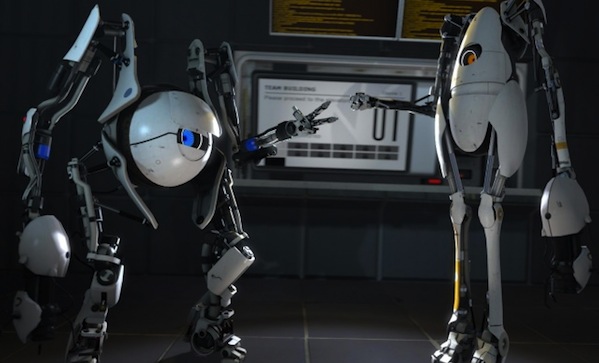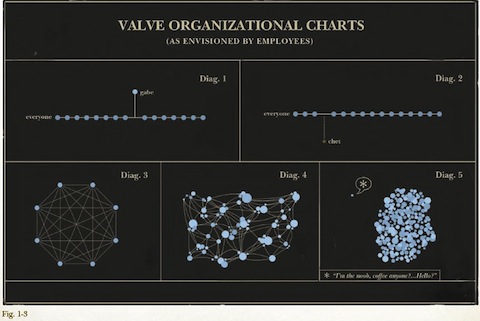At some companies, you get to allocate 10% of your time to self-directed projects. At Valve, that time is 100%.
Perhaps you’re familiar with this new employee handbook (pdf alert) that’s been making the rounds on the web. Needless to say, Valve has a pretty interesting organization chart:
Well, in this week’s Library of Economics and Liberty podcast, Valve’s economist-in-residence Yanis Varoufakis, talks about some of the details of working at Valve. Here are the highlights:
How people are hired
“Let’s say you and I have a chat in the corridor, or in some conference room, or wherever. The result of this chat is that we converge to the view that we need an additional software engineer, or animator, or artist, or hardware person. Or several of them.
“What we can do is, we can send an email to the rest of our colleagues at Valve and invite them to join us in forming a search committee that actually looks for these people without seeking anyone’s permission in the hierarchy, simply because there is no hierarchy.
“And then we form spontaneously the search committee, and then we interview people, first by Skype, and then we bring them in, if they pass the test, to the company for a more face-to-face personalized interview. And anyone who wants to participate does participate.
“And then during that day—it’s usually a day-long event—emails are fired all over the place with views whether this person should be hired or not until some consensus is reached where there’s effectively no one is vetoing the hire of that particular person.”
How people are paid
“This is a haphazard process. The payment mechanism is to a very large extent bonus-based. So the contracts usually have a minimum pay segment in it, which is more or less established by tradition. And then the interesting part in this contract is how much is left to the peer review process, which is very complicated. It involves various layers of mutual assessment.
“In companies like Microsoft or elsewhere, usually the bonus is something between 8, 15, 20 percent of the basic salary. In Valve, I’m told, there’s no upper limit to bonuses. Bonuses can end up being 5, 6, 10 times the level of the basic wage.
“Gabe [Newell, CEO] had this view from the beginning. He wanted a community of partners, he didn’t want to be the boss of anyone or to be bossed around by anyone.”
How people work
“It is important to understand that such spontaneous order-based enterprises rely to a large extent on individuals that believe in the social norms that govern their existence. So by the very nature of the beast, you don’t have people there who try to hide and who try to somehow create a smokescreen around the fact that they’re not very good at what they do.
“Most of the people there, all of them, have been hand-picked to be excellent at what they do. They’re usually on top of their game elsewhere before they join the corporation.
“The mobility within the corporation is a great asset, and everybody recognizes it. Everyone’s desk is on wheels. There are only two plugs that need to be unplugged in order to shift from one team to another.”
How people are fired
“I’ve seen it happen. And it’s never pretty. It involves various communications at first when somebody’s underperforming, or somebody doesn’t seem to fit in with the rest of the company.
“In many occasions people simply don’t fit in not because they’re not productive or good people, but because they just can’t function very well in a boss-less environment. And then there are series of discussions between co-workers and the person whose firing is being canvased or discussed, and at some point if it seems there is no way that a consensus can emerge that this person can stay, some attractive offer is made to the particular person, and usually there’s an amicable parting of ways.”



